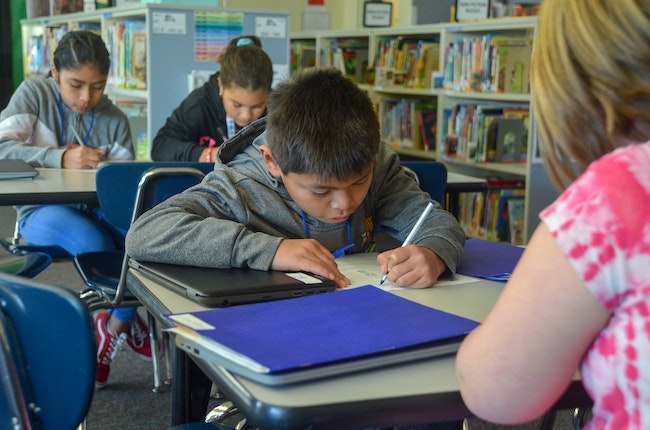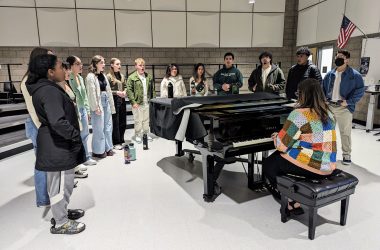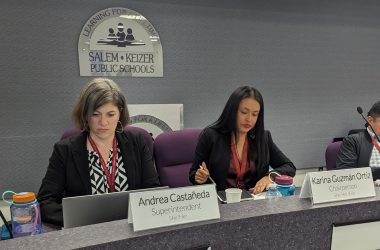 Jared Vergara Santana writes down research questions for his newspaper article in the Hoover Elementary School library on Oct. 29, 2019 (Rachel Alexander/Salem Reporter)
Jared Vergara Santana writes down research questions for his newspaper article in the Hoover Elementary School library on Oct. 29, 2019 (Rachel Alexander/Salem Reporter)
Salem-Keizer schools will begin hiring more social workers and teachers this week after the school board approved a multimillion-dollar plan to help struggling students catch up in school.
The plan is a scaled-back version of one board members first approved in February, when students were learning in physical schools and Oregon was expecting hundreds of millions in new money for K-12 schools after legislators approved a business tax increase to bolster funding in 2019.
Now, the district expects to hire about 80 full-time employees and spend about $11 million on programs to improve student reading at select elementary schools, help students new to the U.S. learn English and provide more counselors and other mental health support in middle and high schools.
DOCUMENTS: Salem-Keizer’s revised plan and original February 2019 plan
The plan also calls for hiring six outreach workers and advocates who can do home visits and work to make sure students stay engaged in school, costing about $500,000. Each will be assigned to a specific group of students who have historically struggled in school, including one for homeless students, one for Pacific Islanders and one for students in foster care.
District administrators said they’re hopeful the new jobs will give them more ways to help students who struggle with online classes as about 42,000 local students are learning remotely. Nationally, educators and researchers are concerned the switch to remote school will widen achievement gaps for low-income students, students of color and students with disabilities.
“We share the same concern and that’s why we’re really pleased that we’ll be able to start enacting our (plan),” said assistant superintendent Iton Udosenata.
The plan would spend about $1.1 million hiring more teachers and a coordinator to focus on reading at eight elementary schools where students historically lag behind on state tests.
About $2 million would go toward teachers to work on revamping the district’s English language development program, which helps middle school students become fluent, and the newcomers program, which teaches students who have recently come to the U.S. and don’t speak English.
Another $2 million funds social and mental health work, including hiring six additional school counselors, one for each high school, and eight social workers.
Six new special education teachers and 10 support secretaries would help reduce caseloads for special education, at a cost of about $1.5 million.
Salem-Keizer initially planned to spend $35 million, its share of the new money flowing to school districts under the landmark Student Success Act. That money would have hired 240 full-time workers for more sweeping changes, including revamping the middle school schedule and buying a new districtwide curriculum to improve math instruction, and hiring new administrators to begin shifting more schools to a dual Spanish-English curriculum for native speakers of both languages.
That plan, which district administrators developed based on priorities from a community task force, drew pushback from some teachers who said too much was being spent on professional development, curriculum and more administrators instead of teachers and other employees working directly with students.
But as Oregon schools and businesses closed their doors in the spring, state tax collection plummeted, and so did the pile of money intended to supplement school budgets. In a special session over the summer, lawmakers elected to keep baseline school funding at pre-pandemic levels, but had to cut from the Student Investment Account, the new pot of money paying for the extra programs.
Salem-Keizer’s share of the money went from about $35 million to about $11 million.
Administrators scaled back all of the programs they’d planned and cut a few which wouldn’t work well in an online environment, said Kraig Sproles, assistant superintendent, while presenting the revised plan to the school board on Oct. 13.
They scrapped an effort to start new after school programs and reduce or eliminate fees for existing ones, since nearly all programs aren’t meeting currently.
Also gone was an administrator to begin planning for adding dual language schools to Salem-Keizer. Currently, the district has three elementary schools where native English and Spanish speaking students are in the same class with a bilingual teacher.
Sproles said there’s no good system for offering that program online.
“It’s much more complicated than just having a Spanish-speaking teacher,” he told the board. “Our K-3 students … are struggling even in one language.”
Sproles said Salem-Keizer expects to receive its full share of funding for the 2021-22 school year and will bring back many of the items cut, including money to begin more dual language offerings.
But the cut led board Director Jesse Lippold to vote no on the new plan, though he said he supported other components. Lippold has advocated for the entire district to adopt a dual-language approach and said he couldn’t support losing that piece of the plan.
The board voted 6-1 to approve the scaled-back version. Their approval means the district can receive money from the state and begin hiring to fill the new jobs.
SUPPORT ESSENTIAL REPORTING FOR SALEM – A subscription starts at $5 a month for around-the-clock access to stories and email alerts sent directly to you. Your support matters. Go HERE.
Contact reporter Rachel Alexander: [email protected] or 503-575-1241.

Rachel Alexander is Salem Reporter’s managing editor. She joined Salem Reporter when it was founded in 2018 and covers city news, education, nonprofits and a little bit of everything else. She’s been a journalist in Oregon and Washington for a decade. Outside of work, she’s a skater and board member with Salem’s Cherry City Roller Derby and can often be found with her nose buried in a book.









